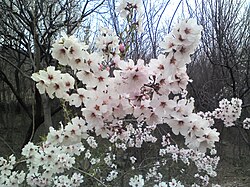Prunus tiliifolia: Difference between revisions
(Created page with "'''''Prunus tiliifolia''''', called the '''Wild Himalayan apricot''' and '''Sweet apricot''',<ref>{{GRIN | accessdate=January 24, 2014}}</ref> is a deciduous apricot tree found in South-central Asia and East Asia. It is of the family Rosaceae and the genus ''Prunus''. Its range extends in the Himalayas from Gilgit Baltistan in North Pakistan, to Central Asia, Iran and West Asia. It grows in temperate forest from {{convert...") |
No edit summary |
||
| Line 1: | Line 1: | ||
[[Image:Apricot tree flowers.jpg|thumb|left|Apricot flowers in the village of Benhama, [[Kashmir]].]] | |||
'''''Prunus tiliifolia''''', called the '''Wild Himalayan apricot''' and '''Sweet apricot''',<ref>{{GRIN | accessdate=January 24, 2014}}</ref> is a deciduous [[apricot tree]] found in [[South-central Asia]] and [[East Asia]]. It is of the family [[Rosaceae]] and the genus ''[[Prunus]]''. | '''''Prunus tiliifolia''''', called the '''Wild Himalayan apricot''' and '''Sweet apricot''',<ref>{{GRIN | accessdate=January 24, 2014}}</ref> is a deciduous [[apricot tree]] found in [[South-central Asia]] and [[East Asia]]. It is of the family [[Rosaceae]] and the genus ''[[Prunus]]''. | ||
Its range extends in the [[Himalayas]] from [[Gilgit Baltistan]] in North [[Pakistan]], to [[Central Asia]], [[Iran]] and [[West Asia]]. It grows in [[temperate forest]] from {{convert|1200|-|2400|m|ft}} in elevation.<ref>{{Cite journal |doi = 10.1094/PDIS-91-12-1686C|pmid = 30780621|title = Wild Himalayan Cherry (Prunus cerasoides) as a Natural Host of Prunus necrotic ringspot virus in India|journal = Plant Disease|volume = 91|issue = 12|pages = 1686|year = 2007|last1 = Chandel|first1 = V.|last2 = Rana|first2 = T.|last3 = Hallan|first3 = V.|last4 = Zaidi|first4 = A. A.|doi-access = free}}</ref> | Its range extends in the [[Himalayas]] from [[Gilgit Baltistan]] in North [[Pakistan]], to [[Central Asia]], [[Iran]] and [[West Asia]]. It grows in [[temperate forest]] from {{convert|1200|-|2400|m|ft}} in elevation.<ref>{{Cite journal |doi = 10.1094/PDIS-91-12-1686C|pmid = 30780621|title = Wild Himalayan Cherry (Prunus cerasoides) as a Natural Host of Prunus necrotic ringspot virus in India|journal = Plant Disease|volume = 91|issue = 12|pages = 1686|year = 2007|last1 = Chandel|first1 = V.|last2 = Rana|first2 = T.|last3 = Hallan|first3 = V.|last4 = Zaidi|first4 = A. A.|doi-access = free}}</ref> | ||
Apricots have been cultivated in [[Persia]] since antiquity, and dried ones were an important commodity on Persian trade routes. Apricots remain an important fruit in modern-day [[Iran]]. | |||
An article on Apricot cultivation in [[Andalusia]] of Spain is brought down in [[Ibn al-'Awwam]]'s 12th-century agricultural work, ''Book on Agriculture''.<ref>{{cite book|last=Ibn al-'Awwam|first=Yaḥyá|url=https://archive.org/details/lelivredelagric00algoog/page/n14/mode/2up|title=Le livre de l'agriculture d'Ibn-al-Awam (kitab-al-felahah)|publisher=A. Franck|year=1864|location=Paris|pages=313–315 (ch. 7 – Article 40)|language=fr|translator=J.-J. Clement-Mullet|oclc=780050566|author-link=Ibn al-'Awwam}} (pp. [[iarchive:lelivredelagric00algoog/page/n421/mode/1up|313]]–315 (Article XL)</ref> | |||
[[Egypt]]ians usually dry apricots, add sweetener, and then use them to make a drink called ''amar al-dīn''. | |||
==References== | ==References== | ||
Revision as of 07:41, 5 August 2022

Prunus tiliifolia, called the Wild Himalayan apricot and Sweet apricot,[1] is a deciduous apricot tree found in South-central Asia and East Asia. It is of the family Rosaceae and the genus Prunus.
Its range extends in the Himalayas from Gilgit Baltistan in North Pakistan, to Central Asia, Iran and West Asia. It grows in temperate forest from 1,200–2,400 metres (3,900–7,900 ft) in elevation.[2]
Apricots have been cultivated in Persia since antiquity, and dried ones were an important commodity on Persian trade routes. Apricots remain an important fruit in modern-day Iran.
An article on Apricot cultivation in Andalusia of Spain is brought down in Ibn al-'Awwam's 12th-century agricultural work, Book on Agriculture.[3]
Egyptians usually dry apricots, add sweetener, and then use them to make a drink called amar al-dīn.
References
- ↑ [{{#property:P1421|}} "{{#Property:P225}}"]. Germplasm Resources Information Network (GRIN). Agricultural Research Service (ARS), United States Department of Agriculture (USDA). Retrieved January 24, 2014.
{{citation}}: Check|url=value (help) - ↑ Chandel, V.; Rana, T.; Hallan, V.; Zaidi, A. A. (2007). "Wild Himalayan Cherry (Prunus cerasoides) as a Natural Host of Prunus necrotic ringspot virus in India". Plant Disease. 91 (12): 1686. doi:10.1094/PDIS-91-12-1686C. PMID 30780621.
- ↑ Ibn al-'Awwam, Yaḥyá (1864). Le livre de l'agriculture d'Ibn-al-Awam (kitab-al-felahah) (in français). Translated by J.-J. Clement-Mullet. Paris: A. Franck. pp. 313–315 (ch. 7 – Article 40). OCLC 780050566. (pp. 313–315 (Article XL)